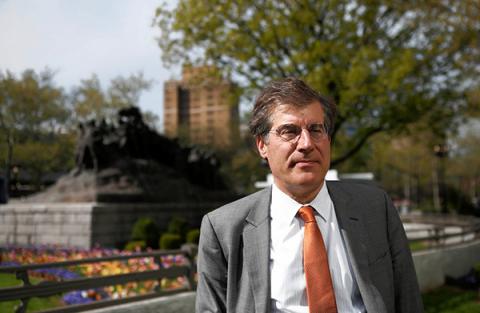Behind Reborn Newark Oasis Stands a 'Park Whisperer' - Wall Street Journal – Dan Biederman

Behind Reborn Newark Oasis Stands a 'Park Whisperer'
Daniel Biederman Also Revamped Bryant Park in Manhattan
By YONI BASHAN
The Wall Street Journal
May 16, 2014
Daniel Biederman, the urban-development guru who led the renovation of Newark's Military Park, says he still feels the same sense of panic at the start of a new project as he experienced during his first assignment 34 years ago.
He had just been given the task of revamping Bryant Park, then a seemingly lost cause of drug dealing and open drinking in Midtown. He was 26 years old, with no experience except for a brief period as chairman of a community board.
Today, Bryant Park is a celebrated public space, attracting thousands of people who visit each day to eat lunch at its movable outdoor furniture, stretch out on its lawn or, if nothing else, use its restrooms, which are festooned with fresh flowers.
Military Park, which reopened Thursday, is a 4.5-acre former training ground in downtown Newark. Not long ago, its lawns and concrete walkways were ragged, and broken lights discouraged people from walking through at night.
As he did in New York, Mr. Biederman is directing a public-private partnership to upgrade the park. Private sources provided about $3 million of the Newark project's $5 million cost.
"We love the idea that the Bryant Park model is spreading, especially to this city," he said.
Mr. Biederman's ability to revive downtrodden spaces has produced widely admired projects.
In Pittsburgh, he revived Schenley Plaza, which for decades had been used as a parking lot. In Dallas, he designed a park with a restaurant and botanical garden and put it on top of a freeway.
"He's totally a park whisperer," said John Schreiber, CEO of the New Jersey Performing Arts Center and one of 11 board directors on the privately funded Military Park Partnership. "He's great at understanding the uniqueness of the community that he's in at the moment."
Mr. Biederman said Newark's strength was its community spirit. When money ran tight, that spirit—and generosity—came through. The chief private sources of funding for the project came from Newark-born philanthropist Raymond Chambers through his foundation, MCJ Amelior, and from insurance giant Prudential Financial Inc.
"In Bryant Park, we ran out of money and no one rushed to write a check," Mr. Biederman said. "In Newark, they write checks."
At Military Park these days, a once-neglected, sword-shaped pool has been reborn as a vibrant floral display of tulips and pansies. Victorian-style lampposts dot the park's perimeter. The cracked and broken concrete has been excavated and repaved, providing a pathway to a newly built plaza with a cafe, public restrooms and free Wi-Fi. Footsteps away is an expanse of lawn earmarked for concerts and movie screenings.
With some irony, Mr. Biederman, 60 years old, traces his course toward a career in urban redevelopment to his to childhood love of baseball. When he was 11, his father, a fabric salesman and later a consultant to garment firms, expressed concern he wouldn't amount to anything if he didn't pursue interests outside of sports. Seeking something with a competitive edge, he chose politics, which introduced him to public works.
He grew up in Westchester County and, after graduating from Princeton University, he went to Harvard Business School. There, he discovered the potential of public-private partnerships, which offered creativity in how to pay for what were ostensibly civic projects. He founded Biederman Redevelopment Ventures in 1998.
For Military Park, Mr. Biederman brought back some of the team that worked on Bryant Park, including the horticulturalist, lighting designer and architect. Bryant's signature features, including flower beds, movable chairs, chess, yoga, T'ai Chi, ping pong and a reading room, also will become staples in Newark.
The end result will, he hopes, change what he and others believe is a distorted perception that Newark can't transcend its troubled past.
"The perception's always been a challenge," said the city's former mayor, Cory Booker, who is now a U.S. senator. He listed new hotels and office towers going up downtown. "We're going through our biggest economic boom since the 1960s."
While many are optimistic about Military Park, some are skeptical about how successful it will be at night. "That area [is] pretty dead after seven," said Jonathan Wharton, an assistant professor of political science at Stevens Institute of Technology in Hoboken, who added he supported the project. "Everyone's getting in their cars and going back to the 'burbs."
An important measure of Military Park's success will be whether it can reach an early target of 400 people during peak periods, such as lunchtime. That is the critical mass required to make people feel safe and attract corporate sponsors for marquee events—free to the public—which produce revenue for the park. Mr. Biederman expects Miliary Park to generate $700,000 in its first year, but he said it ultimately must annually produce about $2 million to sustain itself. Bryant Park generates $13 million a year.
"Over time, the park will generate more and more earned revenue," said Ommeed Sathe, vice president of Prudential Financial. "Money's important, but it's been much deeper than that. It's a persuasive, provocative model for what the city could become."
